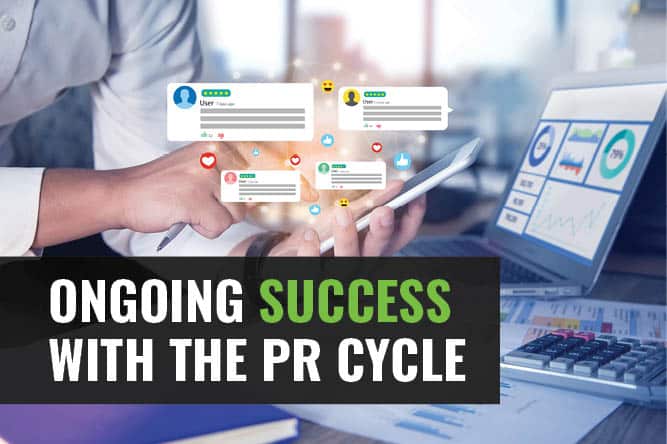Ongoing Success with the PR Cycle

In today’s fast-paced digital landscape, establishing and maintaining a strong public relations (PR) program is crucial for businesses to effectively communicate with their target audience. By implementing an ongoing PR cycle, you can ensure that your brand remains in the public eye, drives customer engagement and ultimately contributes to your company’s success. The key steps involved in the PR cycle are:
- Strategic Planning and Integration
- Building Solid Media Relationships
- Creating Valuable Content
- Listening and Engaging with Customers
- Tracking Success and Evaluating ROI
- Repeating the Process for Continued Success
Step 1: Strategic Planning and Integration
The PR cycle begins with a well-coordinated strategic approach. Align your PR goals with your overall marketing plan to ensure a cohesive and consistent brand message across all channels. By integrating PR activities with your broader marketing efforts, you can maximize their impact and reach a wider audience.
Also, it is very difficult to gauge success without setting specific end goals. “We want to grow our public perception” is a nice-sounding phrase but it is too vague. Setting specific, measurable, achievable, relevant and time-bound (SMART) goals provides clarity and direction to PR efforts. For example, a SMART goal for PR could be to increase media mentions by 25% within the next quarter by securing coverage in at least three influential online publications. Success could then be measured through media monitoring tools and tracking progress against the set timeframe.
Step 2: Building Solid Media Relationships
The success of your PR cycle relies heavily on nurturing strong relationships between your company and the media. It’s essential to recognize that media has evolved beyond traditional print and electronic outlets. Today, bloggers, online wire services, forum authors, and social media influencers play a vital role in shaping public opinion. Regularly engage with these communicators who interact with your customers daily, as their endorsement and coverage can significantly impact your brand’s visibility.
Step 3: Creating Valuable Content
To keep the PR cycle alive and thriving, you must consistently provide valuable and engaging content to all chosen media outlets. Gone are the days when a monthly press release would suffice. Embrace a proactive approach by generating a steady flow of informative articles, videos, social media posts and other content that engages your target audience. By doing so, you’ll position your brand as a reliable source of information and thought leadership within your industry.
Step 4: Listening and Engaging with Customers
An effective PR cycle requires active listening and engagement with your customers. Pay attention to their needs, address their questions and provide solutions to their problems promptly. By actively participating in conversations, you can foster a positive brand perception and build a loyal customer base. Remember, your customers are your best brand advocates and their word-of-mouth recommendations can amplify your PR efforts.
Step 5: Tracking Success and Evaluating ROI
Tracking the success of your PR tactics is crucial for evaluating the effectiveness of your efforts. Monitor media coverage, engagement metrics and customer feedback to gauge the impact of your PR campaigns. Regularly communicate with your brand advocates to understand their level of interest and determine if they are effectively spreading your message. Lastly, assess the return on investment (ROI) by evaluating the value of your coverage against the cost of production and distribution.
Step 6: Repeating the Process for Continued Success
The PR cycle emphasizes the importance of repeating the process for continuous growth and success. By staying adaptable and repeating the planning process, businesses can maintain a strong brand presence and drive ongoing business growth. Embracing the iterative nature of the PR cycle and committing to its repetition ensures businesses remain at the forefront of their industry, capitalize on evolving opportunities and establish themselves as trusted and relevant entities in the eyes of their target audience.
Conclusion
The PR cycle is a dynamic and invaluable component of a successful marketing strategy. By following a well-defined PR plan and committing marketing resources throughout all stages of the cycle, you can achieve strong results and grow your business. Remember, the PR cycle is an ongoing process, so continuously assess and refine your strategies to adapt to changing market trends and consumer behaviors.
So, how well are you faring in the PR cycle? Whether things are going great and you’re coasting downhill, or things are tough and you’re pedaling like crazy, the important thing is to stay in motion. Public Relations should be central to your efforts and integrated into your daily activities. If this sounds daunting or unachievable, keep in mind that Callis has been helping our clients with this cycle for well over three decades and we can help you too.
This article was previously published on September 13, 2011 and updated on June 8, 2023.

